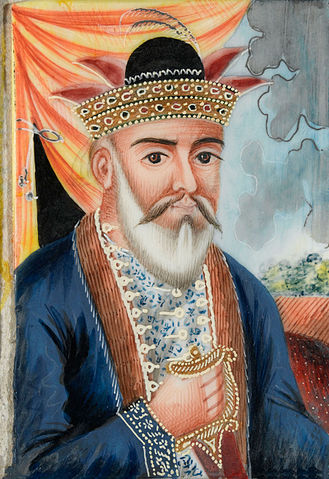 |
This is a file from the Wikimedia Commons. Information from its description page there is shown below.
Commons is a freely licensed media file repository. You can help.
|
Summary
| DescriptionDost Mohammad Khan of Afghanistan.jpg |
01. Amir Dost Mohammed Khan Dost Mohammed Khan (1793-1863), a member of the Barakzai dynasty, was Amir of Afghanistan from 1826 to 1839. His country’s position between the Russian Empire and India meant that the British East India Company was anxious to ensure that a pro-British Amir was on the throne at Kabul. Fearful of a Russian invasion of India via Afghanistan, in 1837 the British sent an envoy to Kabul to gain his support. Dost Mohammed was in favour of an alliance, but when the British refused to help him regain Peshawar, which the Sikhs had seized in 1834, he prepared to talk to the Russians, who sent an envoy to Kabul. This led Lord Auckland, the Governor-General of India, to conclude that Dost Mohammed was anti-British. The decision was taken to replace him as Amir with a former ruler, Shah Shujah.
In March 1839 a British force advanced through the Bolan Pass, and on 26 April reached Kandahar. Shah Shujah was proclaimed ruler, and entered Kabul on 7 August, while Dost Mohammed sought refuge in the Hindu Kush. The British eventually caught him on 4 November 1840. He remained in captivity during their occupation and the disastrous retreat from Kabul in January 1842. Following the British recapture of Kabul in the autumn of 1842, Dost Mohammed was restored to the throne, the unpopular Shah Shujah having been murdered. The Company decided that occupying the country would cost too much in men and money and withdrew. Dost Mohammed reigned until his death in 1863. With some exceptions, his relationship with British India was friendly, and from 1855 regulated by treaty. (NAM 1964-08-44)
|
| Date |
1835 |
| Source |
National Army Museum - The Road To Kabul: British armies in Afghanistan, 1839-1919 |
| Author |
British Company artist |
Licensing
| Public domainPublic domainfalsefalse |
 |
This UK artistic work, of which the author is unknown and cannot be ascertained by reasonable enquiry, is in the public domain because it is one of the following:
- A photograph, which has never previously been made available to the public (e.g. by publication or display at an exhibition) and which was taken more than 70 years ago (before 1st January 1943); or
- A photograph, which was made available to the public (e.g. by publication or display at an exhibition) more than 70 years ago (before 1 January 1943); or
- An artistic work other than a photograph (e.g. a painting), which was made available to the public (e.g. by publication or display at an exhibition) more than 70 years ago (before 1 January 1943).
 This tag can be used only when the author cannot be ascertained by reasonable enquiry. If you wish to rely on it, please specify in the image description the research you have carried out to find who the author was. This tag can be used only when the author cannot be ascertained by reasonable enquiry. If you wish to rely on it, please specify in the image description the research you have carried out to find who the author was.
 The above is all subject to any overriding Publication right which may exist. In practice, Publication right will often override the first of the bullet points listed. The above is all subject to any overriding Publication right which may exist. In practice, Publication right will often override the first of the bullet points listed.
Unpublished anonymous paintings remain in copyright until at least 1 January 2040. This tag does not apply to engravings or musical works. More information.
|
|
File usage
The following pages on Schools Wikipedia link to this image (list may be incomplete):



